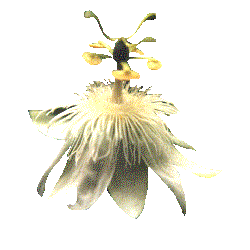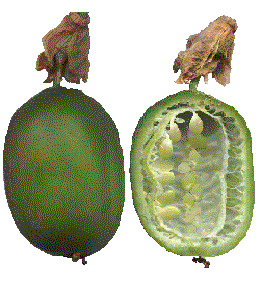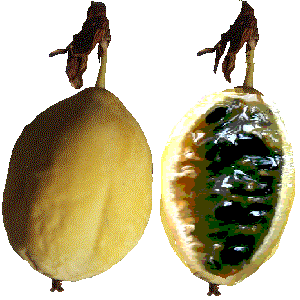Seeds develop from the ovules in the female plant, after they have been fertilised by the pollen from the male parent plant. This is termed 'sexual reproduction', as seeds contain the genes of both the male and female parent, and usually both male and female flowers are required to produce seeds. Sometimes, the male and female flowers are from separate plants, sometimes they are from the same plant, and sometimes a flower may be fertilised by its own pollen.
The ovules are the embryos from which the seed will develop. At the time of fertilisation, they are very small compared to the mature seed. Without being fertilised (in most cases), the ovules will not develop into seeds, any more than pollen can. So in order to develop into seeds, the ovules must first be fertilised.
We can often judge how close the seeds are to being ripe from the size or colour of the fruit or seedpod.
This is a Passionflower. In the photos, the petals are brown and shrivelled at the top, and the dried stigma is at the bottom.
The ovary is a small oval underneath the stigma, which in this species is divided into three. Underneath the ovary are the five stamens.
At this stage, the seeds are too small to be visible.
As the seeds develop, the ovary gets bigger, and at this stage we can recognise it as a seedpod, or, in this case, a fruit. Inside the developing seedpod, the seeds are still barely visible around the edge of the fruit, and most of the seedpod is empty space.
Each seed is attached to the wall of the ovary by a small stalk, through which it receives the food it needs to grow. It is therefore vital that the seeds remain attached to the ovary while they are developing.
The seeds need to form a tiny root and shoot, and to collect a store of food for the plant to use when it germinates before it has developed sufficiently to gather its own food supply.
The seedpod grows larger, but even when it has almost reached its full size, the seeds are still soft and green, most of the seedpod is still empty space, and the seedpod is still hard and green.
The seeds still need to develop a hard covering that will protect them until they are able to germinate.
The mature seedpod has reached its full size and has begun to change colour. The inside of the seedpod is full of seeds and the juicy flesh that will attract animals to eat the fruit and disperse the seeds. The seeds are large, fully formed, have a hard protective coat and may no longer be connected to the wall of the fruit.
If we left the fruit on the plant, the flesh and juice would dry up, and the pod would wither and dry, because it is no longer being supplied with food from the parent plant. Eventually the pod would split open to release the seeds.
In the example, the seedpod is a Passionfruit, but the development of all seeds follows the same pattern. Seeds cannot be produced unless the flower has been fertilised, and seeds are not viable unless they are mature and ripe. Unripe seeds are soft, white or green, and enclosed in a hard green fleshy fruit (pod). When seeds are ripe and mature, they change to brown or green and develop a hard covering, and the seedpod dries out and changes to white or brown and eventually splits to release them.
Producing seeds uses a lot of the plant's energy. If the plant is dead or dying, it will not have enough energy to complete the process. This is one of the reasons you are unlikely to be able to get seeds from cut flowers. The plant needs to be able to gather food while it is developing seeds, and the seedpod needs to remain attached to the parent plant until the seeds are fully developed.
Development of the seeds, from fertilisation to shedding of the ripe seeds, can take several weeks or even months, but seeds gathered before the process has been completed will not be viable.
If you want to collect seeds from the plants in your garden, you can help by ensuring that the plant has enough food and water to give it the energy it needs to produce seeds.
Other entries with information which might be useful
Some examples of unripe seeds in unripe seedpods
Different types of seed containers
Diagram of a seed
Diagram of a flower



